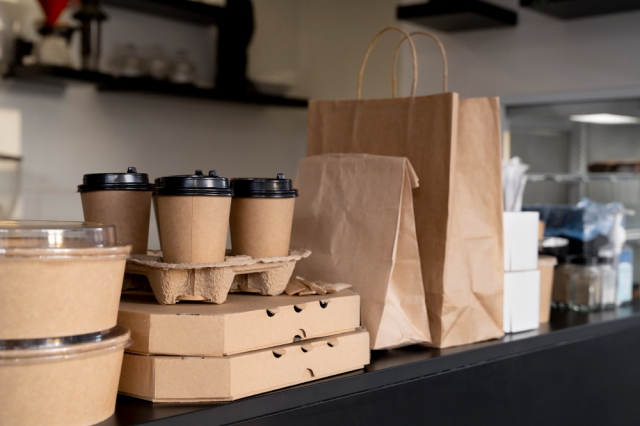Rampant packaging waste compels society to renew systems balancing ecological health with quality of life. Industry, government, science and consumers now collectively invest in innovation for sustainability.
Leading companies future-proof operations while benefiting revenue. Individuals catalyze change through daily eco-conscious purchase choices, gradually bending supply chains. Shared commitment ignites hope of prosperity grounded in environmental stewardship.
Environmental Impacts of Conventional Food Packaging
The materials commonly used in food packaging like plastics have serious environmental impacts. During their extremely slow decomposition over centuries, they leach toxic pollutants into soil and water systems. These contaminants make their way into the food chain, negatively affecting wild habitats, livestock, and human health.
The scale of plastic pollution from packaging also contributes to phenomena like ocean garbage patches. Plastic debris congest marine ecosystems, entangling and poisoning fish, seabirds, and mammals.
Defining Sustainable Food Packaging
Sustainable packaging aims to transform materials usage and processes across the entire lifecycle of packages. It minimizes harm starting from the extraction and harvesting of raw input materials through each phase of manufacturing, transport, storage, use by consumers, and finally end-of-life disposal or recycling.
The goal is to design out negative externalities at each step while delivering products safely to consumers in high-quality condition. This encompasses increased dependence on renewable plant-based inputs, cleaner production practices, smarter delivery mechanisms, reduced waste generation, and closed-loop reuse of materials after consumption.
Importance of Sustainable Food Packaging
Well-designed sustainable packaging confers ecological advantages. This includes lower carbon emissions, decreased pollution, and lighter resource consumption. Over time, the cumulative impact from billions of optimized packages can help mitigate climate change risks and preserve biodiversity.
There are also potential public health gains - curbing the use of hazardous chemical additives and cutting contaminants in water and food. Plus, sustainable materials often weigh less, saving transport fuel and costs.
Biomaterials in Packaging
A range of biomaterials show promising potential, from sustainably farmed wood fibers to dried agricultural leftovers to algae and fungi. These renewable inputs have low carbon footprints compared to plastic derived from fossil fuels. Many naturally decompose without releasing methane and other greenhouse gasses common in landfills.
Some organisms even have built-in antimicrobial properties that can extend food freshness and safety. Ongoing research seeks to enhance attributes like barrier strengths while assuring biocompatibility along the value chain.
Food Packaging Innovations
Several nascent technologies indicate a wave of next-gen sustainable packaging. One route pursues Internet-of-Things tools like smart RFID tags to track real-time conditions throughout global supply chains. The data helps optimize handling and transport for quality and freshness.
Other advances experiment with multilayer materials that change permeability in response to the surrounding environment. For example, emitting a color or fragrance when food inside starts spoiling.
The Simply Eco Packaging Advantage
Creative solutions can spur sustainability even using existing methods. Case-ready meat packages concentrating multiple products together, for instance, improve loading efficiency over individual polystyrene trays. This cuts the number of truck trips and related carbon emissions to transport the same quantity from farms to retailers.
Finding ways to right-size packaging close to actual product dimensions also limits material needs. And reusable systems for groceries and take-out food containers provide consumers reliable alternatives to single-use packages like coffee cups.
Consumer Preference for Eco-Packaging
Consumer surveys reveal strengthening environmental values and willingness to change entrenched habits around convenience packaging. For example, more shoppers now bring reusable bags and containers when acquiring groceries and meals-to-go.
Ecolabels on products also influence buying decisions for a growing segment of shoppers. They trust respected certifications as shorthand guidance to eco-friendly brands.
In response, big retailers highlight sustainability initiatives on shelves and websites. This signaling can accelerate adoption of best practices across entire industry supply chains.
Economic Benefits of Green Packaging
Done well, sustainable transitions in packaging create value for both business and environmental bottom lines. Units like Unilever's Clean Future division aim to pioneer new models that recoup upfront investment costs over reasonable timeframes.
Savings accumulate from lighter transportation loads, fewer discarded products due to freshness innovations, and consumer goodwill for brand purpose. Once perfected, platforms can scale reuse programs across global operations.
Legal Requirements and Standards
Stricter legislation in major markets compels greener packaging. Single-use plastic bans have gained traction in Europe, North America, and Asia-Pacific countries, though enforcement mechanisms remain uneven. Standards for recycled content and biodegradability are also emerging.
To prepare for expanded regulations, prudent multinationals already exceed baseline compliance in operations. This builds resilience while gathering data to influence future policy frameworks consistent with sustainability targets.
Transitioning to Sustainable Practices
Shifting to sustainable packaging models requires adjusting interconnected systems spanning materials sourcing, production, distribution and waste recovery. Gradual conversions allow testing modifications before widespread implementation.
Early initiatives could pilot blending recycled or bio-based materials into existing packaging. Design changes may trial recyclable or reusable containers along select product lines and regions. Sophisticated data analytics also help optimize handling to reduce food wastage, transport distances, and fuel usage across supply chains.
Multi-pronged efforts to improve packaging properties while diminishing waste across entire life cycles exemplify the systems thinking needed to transition towards holistic sustainability.
Overcoming Challenges in Transitioning
While promising ecologically, sustainable packaging transitions face practical hurdles around inconsistent supply streams for alternative materials, lack of supporting infrastructure to collect and reprocess used packages, and pushback from budget-conscious procurement managers.
Success hinges on framing environmental upgrades as long-term investments that serve both ethical and financial interests rather than just feel-good extravagances. Partnerships across value chains help de-risk initial forays and build confidence.
Eco-Branding and Marketing Opportunities
Packaging makeovers let marketing teams spotlight corporate social responsibility efforts to key audiences. Updated designs broadcast the brand's environmental commitments directly on-shelf and at point-of-sale.
Companies can weave paddling reduction statistics and materials innovations into brand narratives across channels - product labels, websites, social posts, and commercials. These messages reinforce eco credentials to build customer loyalty and trust.
Sustainable Packaging in Industry Leaders
As concepts prove out, major brands across sectors now chase packaging sustainability targets. Nestlé aims for 100% reusable or recyclable options by 2025. Unilever pursues annual double-digit percentage decreases in virgin plastic usage. PepsiCo plans to test sales of snack foods in reusable containers relying on deposit return schemes.
These ambitions indicate that the consumer goods industry recognizes packaging among the top priorities for their emissions reductions and circular economy pledges.
Futuristic Sustainable Packaging Concepts
Radical innovations like multi-layered packaging with advanced thermal adhesives could maintain optimal temperatures for perishables without refrigeration for weeks. Or consumers may someday subscribe to personalized meal ingredients replenished in customized, microwavable containers. Mini factories equipped for closed-loop plastic recycling would reshape returned packaging.
While speculative, such innovations illuminate a future where sustainability becomes the default rather than a luxury add-on. The promise of high-functionality packaging harmonizing environmental health with consumer convenience nears as rapid advances converge across sciences and technologies.
Wrapping it Up
Sustainable food packaging has developed past niche status into a mainstream business imperative. Companies failing to instigate transformations risk losing step with competitors and consumer demand. Intelligent leaders approach the area as an opportunity to future-proof operations while benefiting the planet.
Symbiotic partnerships across sectors can spread both costs and successes more broadly. And as individuals, people fuel wider progress through their spending and lifestyle decisions.






